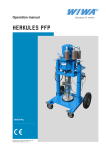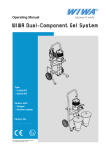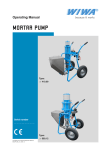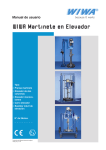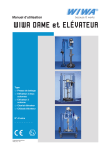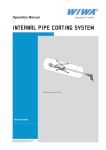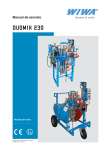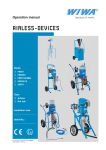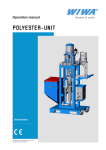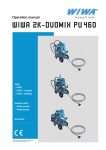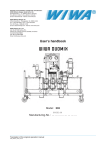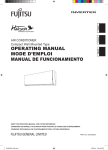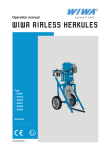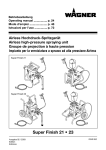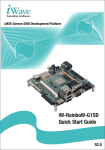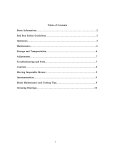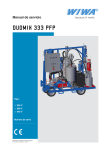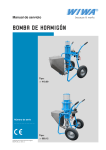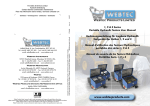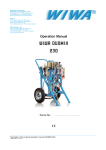Download Operation manual DUOMIX 230
Transcript
Operation manual DUOMIX 230 Serial-No. ⸏⸏⸏⸏⸏⸏⸏⸏ Translation of the original operation manual DM230_DBK_en_1206 · rs Contents Contents 1 Foreword........................................................................................................5 2 Safety..............................................................................................................6 2.1 Explanation of symbols.................................................................................6 2.2 Safety notes..................................................................................................8 2.2.1 Operating pressure.............................................................................8 2.2.2 Risks due to the spray jet...................................................................8 2.2.3 Risks due to electrostatic charge........................................................9 2.2.4 Explosion protection...........................................................................9 2.2.5 Health risks.......................................................................................10 2.3 Information signs on the unit.......................................................................10 2.4 Safety features............................................................................................ 11 2.4.1 Safety valves.................................................................................... 11 2.4.2 Compressed air shut-off valve..........................................................12 2.4.3 Ground cable....................................................................................12 2.4.4 Safety rupture discs..........................................................................12 2.4.5 Spray gun lock..................................................................................12 2.5 Operating and maintenance personnel.......................................................13 2.5.1 Obligations of the unit owner............................................................13 2.5.2 Personnel qualification......................................................................13 2.5.3 Authorized operating personnel........................................................13 2.5.4 Personal protective equipment.........................................................13 2.6 Notes on warranty.......................................................................................14 2.6.1 Conversions and alterations.............................................................14 2.6.2 Spare parts.......................................................................................14 2.6.3 Accessories.......................................................................................14 2.7 Emergency procedures...............................................................................15 2.7.1 Shutting down and depressurizing the unit.......................................15 2.7.2 Leakages..........................................................................................15 2.7.3 Injuries..............................................................................................15 2.7.4 Fires..................................................................................................15 3 Unit description...........................................................................................16 3.1 Intended use...............................................................................................16 3.2 Unit configuration........................................................................................17 3.3 Material feed...............................................................................................20 3.3.1 Suction pipes....................................................................................20 3.3.2 Feed drums.......................................................................................20 3.3.3 Feed pumps......................................................................................20 3.4 Mixing unit...................................................................................................21 3.4.1 Standard mixing unit.........................................................................21 3.4.2 Mixing unit with separate flushing levers..........................................22 3.4.3 External mixing unit..........................................................................23 3.5 Maintenance unit........................................................................................24 3.5.1 Standard maintenance unit...............................................................24 3.5.2 Maintenance unit with remote controlled compressed air control.....24 Translation of the original operation manual DUOMIX 230 DM230_BAoDB_en_1307 · rs 3 Contents 3.6 Optional extensions and accessories.........................................................25 3.6.1 Pressure and dosing control.............................................................25 3.6.2 Material heating................................................................................25 4 Transport, installation and assembly........................................................26 4.1 Transport.....................................................................................................26 4.2 Installation location.....................................................................................27 4.3 Assembly....................................................................................................27 4.3.1 Assembling spray hose and spray gun.............................................28 4.3.2 Inserting the filter elements into the high pressure filter...................28 4.3.3 Connecting the compressed air supply.............................................28 4.3.4 Grounding the unit............................................................................28 4.3.5 Filling in release agent and pneumatic oil.........................................29 4.3.6 Assembling the hose package and the external mixing unit (optional). 29 5 Operation......................................................................................................30 5.1 Taking the unit into service..........................................................................30 5.2 Coating.......................................................................................................31 5.2.1 Adjusting spraying pressure..............................................................32 5.2.2 Adjusting the pressure and dosing control........................................32 5.2.3 Tips for good coating........................................................................32 5.3 Flushing......................................................................................................33 5.4 Pressure relief.............................................................................................33 5.5 Decommissioning.......................................................................................33 5.6 Complete cleaning......................................................................................34 5.7 Material change..........................................................................................35 5.8 Waste disposal............................................................................................35 6 Maintenance.................................................................................................36 6.1 Regular inspections....................................................................................36 6.2 Maintenance plan.......................................................................................37 6.3 Maintenance unit........................................................................................37 6.3.1 Checking the lubricant level in the fog oiler......................................37 6.3.2 Checking and adjusting the fog oiler................................................38 6.3.3 Checking and cleaning the water separator.....................................38 6.4 Check release agent for material residues.................................................38 6.5 Cleaning the filter elements in the high pressure filters..............................39 6.6 Drying the moisture filter.............................................................................39 6.7 Recommended operating materials............................................................40 6.8 Filter elements for high-pressure filters......................................................40 6.9 Special tools...............................................................................................41 7 Rectification of faults..................................................................................42 8 Technical data..............................................................................................45 8.1 Machine card..............................................................................................45 8.2 Type plates..................................................................................................45 4 Translation of the original operation manual DUOMIX 230 DM230_BAoDB_en_1307 · rs Foreword 1 Foreword Dear Customer! We are delighted that you have decided in favour of a DUOMIX 230 from our company. This operating manual is intended for the operating and maintenance personnel. It contains all the information required to working with this unit. The owner of the unit must ensure that the operator of the unit always has an operating manual at his/her disposal in a language he/she understands! Safe and reliable operation of the unit requires further information in addition to this operating manual. Read and comply with the applicable guidelines and accident prevention instructions for your country. In Germany, these are: ➤➤ the “Richtlinien für Flüssigkeitsstrahler (Spritzgeräte)” (Guidelines for Liquid Jets), issued by the Hauptverband der Gewerblichen Berufsgenossenschaften. ➤➤ the BGR 500, chapt. 2.29 „Verarbeiten von Beschichtungsstoffen“ (Application of Coating Materials), ➤➤ the BGR 500, chapt. 2.36 „Arbeiten mit Flüssigkeitsstrahlern“ (Working with Liquid Jets), both issued by the Berufsgenossenschaft der Gas-, Fernwärme- und Wasserwirtschaft. We strongly recommend to add all relevant guidelines and accident prevention instructions to this operating manual. Moreover the manufacturer’s instructions and guidelines for coating or feeder materials are to be respected at all times. However, if you have any questions, please do not hesitate to contact us. Excellent work results with your WIWA DUOMIX 230 wishes WIWA Wilhelm Wagner GmbH & Co. KG. Copyright © 2013 WIWA The copyright for this operating manual lies with WIWA Wilhelm Wagner GmbH & Co. KG Gewerbestr. 1-3 • 35633 Lahnau • Germany Phone: +49 6441 609-0 • Fax: +49 6441 609-50 • E-Mail: [email protected] • Internet: www.wiwa.de This operating manual is solely intended for personnel involved in preparation,operation and servicing. It is prohibited to pass on this operating manual for reproduction, utilisation or communication of its contents, unless this has been explicitly permitted. Infringements incur an obligation to pay damage compensation. All rights reserved in the event of registration of the patented design, industrial design or registered design. This operating manual only applies in conjunction with the machine card that was given to you with the user manual for your unit. Please check that the type plate data is identical with the information on the machine card. Please notify us immediately if there are discrepancies, if the user manual has been incorrectly compiled or if the type plate is missing. Translation of the original operation manual DUOMIX 230 DM230_BAoDB_en_1307 · rs 5 Safety 2 Safety This unit has been designed and manufactured while taking into consideration all safety-related aspects. It corresponds to the current standard of technology and to applicable accident prevention regulations. The unit left the factory in perfect condition and guarantees a high level of technical reliability and safety. Nevertheless, there are certain risks that can arise from incorrect operation or misuse: ➤➤ to life and limb of the operator or third party, ➤➤ to the unit and other material assets of the owner, ➤➤ to the efficient working capacity of the unit. In principle you should refrain from any work method that could affect the safety of operating personnel and the unit. All persons involved in set-up, commissioning, operation, maintenance, repair and servicing of the unit must have read and understood the operating manual beforehand, especially the chapter “Safety”. Your safety is at stake! We recommend to the owner of this unit to have this confirmed in writing. 2.1 Explanation of symbols Safety notes warn of potential accident hazards and identify the necessary measures to prevent accidents. In the operating manuals from WIWA safety notes are particularly highlighted and marked as follows: DANGER Highlights accident hazards which if disregarding the safety note will result most likely in severe or even fatal injuries! WARNING Highlights accident hazards which if disregarding the safety note can result in severe or even fatal injuries! CAUTION Highlights accident hazards which if disregarding the safety note can result in injuries! Highlights important information for the proper use of the unit. Disregarding this information can result in damage to the unit or to the environment. 6 Translation of the original operation manual DUOMIX 230 DM230_BAoDB_en_1307 · rs Safety Depending on the hazard source different pictograms are used in safety notes about accident hazards with risk of injury – examples: General accident hazard Risk of explosion from explosive atmospheres Risk of explosion from explosive substances Accident hazard from voltage or static electricity Danger of crushing from moving components of the unit Risk of burns from hot surfaces Security orders primarily indicated to wear protective equipment. They are also highlighted and marked as follows: Wear protective clothing Highlights the order to wear the prescribed protective clothing to protect against skin injuries caused by spraying material or gases. Use eye protection Highlights the order to use eye protection in order to prevent your eyesigh from being damaged by material splatter, gases, vapors or dust. Wear ear defenders Highlights the order to use ear defenders in order to prevent your sense of hearing from being damaged by noise. Use a respiratory protection mask Highlights the order to use a respiratory protection mask in order to prevent your respiratory tract from being damaged by gases, fumes or dusts. Wear protective gloves Highlights the order to wear protective gloves with lower arm protection to protect against burn injuries caused by heated materials. Wear protective footwear Highlights the order to wear protective footwear to prevent injuries to the feet due to tumbling, falling or rolling objects, and a slip on slippery surfaces. Reading is an absolute must Highlights references to guidelines, work and operating manuals, which must be strictly followed. Translation of the original operation manual DUOMIX 230 DM230_BAoDB_en_1307 · rs 7 Safety 2.2 Safety notes Please remember that the DUOMIX 230 works with extremely high pressures and may cause life threatening injuries if used inappropriately! Always observe and follow the information in this operating manual as well as in the separate operating manuals for individual components of the unit or the optionally available accessories. 2.2.1 Operating pressure WARNING Components that do not comply with the maximum permissible operating pressure may burst and cause severe injuries. ➤➤ The specified maximum operating pressures must generally be complied with for all components. In case of varying operating pressures the lowest value is always valid as the maximum admissible operating pressure for the entire unit. ➤➤ Material hoses and hose assemblies must comply with the maximum operating pressure, including the required safety factor. ➤➤ Material hoses must be leak tight and free of kinks, signs of abrasion or bulges. ➤➤ Hose connections must be tight. 2.2.2 Risks due to the spray jet WARNING The material is discharged from the spray gun under very high pressure. Due to its cutting effect the spray jet can cause severe injuries by penetrating the skin or entering into the eyes. ➤➤ Never point the spray gun at yourself, other persons or animals! ➤➤ Do not hold your fingers or hands in front of the spray gun! ➤➤ Do not reach with your hands into the spray jet! WARNING Any unintended escape of material from the spray gun can cause damage to persons or property. ➤➤ Always secure the spray gun, even for shortest work breaks! ➤➤ Always make sure that the spray gun is properly secured before each use! 8 Translation of the original operation manual DUOMIX 230 DM230_BAoDB_en_1307 · rs Safety 2.2.3 Risks due to electrostatic charge WARNING The high flow velocities associated with the Airless spraying method may cause static charging. Static discharges can cause fire and explosion. ➤➤ Always use open containers! ➤➤ Never spray solvents or solvent containing materials into cone-top cans or drums with bunghole! ➤➤ Stand the containers on a grounded surface. ➤➤ When using metal containers watch out for contact between spray gun and container wall. ➤➤ Only use conductive material hoses. All original material hoses from WIWA are conductive and perfectly adapted to our units. 2.2.4 Explosion protection WARNING Units designed without explosion protection must not be used in workshops that come under the explosion protection ordinance! Explosion protected units fulfil the explosion protection requirements of the Directive 94/9/EC for the explosion group, unit category and temperature class specified on the type plate or in the declaration of conformity. The operator is responsible for determining the zone allocation according to the Directive of EC 94/9/EC, Appendix II, no. 2.1-2.3 when observing the measures of the responsible inspecting authority. The operator is responsible for checking and ensuring that all technical data and markings according to ATEX correspond with the necessary requirements. Please note that several components have their own type plate with separate marking according to ATEX. In this case the lowest explosion protection of all attached markings applies for the entire unit. Applications where the malfunction of the unit can lead to danger to personnel must be provided with respective safety measures by the operator. However, if agitators, heaters or other electrically accessories are additionally mounted, one must check the explosion protection. Plugs for heaters, agitators, etc. that do not have explosion protection, may only be plugged in outside of areas that fall under the explosion protection ordinance, even if the accessory equipment as such is explosion protected. Translation of the original operation manual DUOMIX 230 DM230_BAoDB_en_1307 · rs 9 Safety 2.2.5 Health risks Follow the safety notes and dosing information of the manufacturer and the generally applicable regulations when handling paints, solvents, oils, greases and other chemical substances. Rests of paints, solvents, oils, greases and other chemical substances must be collected in accordance with statutory provisions concerning recycling and waste disposal. The official local waste water laws are valid. CAUTION Depending on the materials being applied solvent vapours may be generated which could cause damage to health and objects. ➤➤ Always ensure sufficient aeration and ventilation at the workplace. ➤➤ Always observe the processing instructions issued by the material manufacturers. CAUTION Solvents or other harmful substances are not suitable to clean your skin and can result damage to health. ➤➤ Use only appropriate skin protection, skin cleaning and skin care products. In closed or pressurized systems dangerous chemical reactions may occur if parts made of aluminium or galvanized parts come into contact with 1.1.1 trichloroethane, methylene chloride or other solvents containing halogenated hydrocarbons (CFC’s). If you want to process materials containing the afore mentioned substances, we recommend to consult the material manufacturer to clarify the usability of such substances. For these materials we have a range of rust and acid proof versions available. 2.3 Information signs on the unit Information signs attached to the unit, such as safety information (see Fig. 1) refer to possible danger areas and must be strictly followed. They must not be removed from the unit. Damaged and illegible information signs must be replaced immediately. Apart from this you should also read and follow the safety notes in the operating manual! Fig. 1: Safety Information 10 Translation of the original operation manual DUOMIX 230 DM230_BAoDB_en_1307 · rs Safety 2.4 Safety features Safety features must be checked with the unit depressurized: ➤➤ before initial commissioning, ➤➤ always before starting work, ➤➤ after completion of setup work, ➤➤ after cleaning, maintenance and repair work! Check list: 55 Lead seal on the safety valve still intact? 55 Safety valves externally free of damage? 55 Function of compressed air shut-off valve correct? 55 Ground cable free of damage? 55 Ground cable connections on unit and conductor in good condition? 55 Correct functioning of safety levers on spray gun? WARNING If one of the safety features is missing or not fully functional, the operating safety of the unit cannot be guaranteed! ➤➤ If you discover any faults on the safety features or other deficiencies on the unit, stop operation of the unit immediately. ➤➤ Only resume operation of the unit after the fault has been completely rectified. 2.4.1 Safety valves The DUOMIX 230 is equipped with safety valves in the air motors of the main pump (see Fig. 2), the flushing pump and the feed pumps (if present). The safety valves ensure that the max. permissible air inlet pressure is not exceeded. If the air inlet pressure exceeds the fixed limiting value at one of the points mentioned above, the corresponding safety valve will blow off. Fig. 2: Safety valve WARNING If the maximum permissible air inlet pressure is exceeded, components may burst. This may result in damage to persons and property. ➤➤ Never allow the unit to run without or with defective safety valves! ➤➤ If a safety valve needs to be replaced, you can find the corresponding order number on the machine card. ➤➤ When using new safety valves make sure that the valves have been set to the max. permissible air inlet pressure of the DUOMIX 230 as required for the mixing ratio (see type plate or machine card) and sealed with a lead seal. Changing the mixing ratio may cause a change in pressure ratio and thus require the adaptation of the max. permissible air inlet pressure of the main pump. In this case you would have to replace the safety valve of the main pump and the type plate – you should absolutely contact WIWA. Translation of the original operation manual DUOMIX 230 DM230_BAoDB_en_1307 · rs 11 Safety 2.4.2 Compressed air shut-off valve The compressed air shut-off valve on the air maintenance unit interrupts the air supply for the entire unit. Once the air supply is cut off, the unit is still under pressure. The pressure relief of the unit must be done by the spray gun and the return flow ball valve on the high pressure filters. Fig. 3: Compressed air shut-off valve 2.4.3 Ground cable The unit must be grounded to an electrically conductive object with the ground cable, to prevent electrostatic charging. Adhesive labels on the high pressure filters expressly inform about the required grounding. Please order the ground cable immediately (orderno.: 0474487) if lost or damaged. Fig. 4: Ground cable 2.4.4 Safety rupture discs Die Berstscheiben verhindern ein deutliches Überschreiten des zulässigen Betriebsdrucks. Sie befinden sich in der Verschraubung hinter den Hochdruckfiltern. If a safety rupture disc is damaged material will escape into the collecting vessel of the rupture disc safety system. Fig. 5: Safety rupture disc In this case the safety rupture disc must be replaced immediately. You find the corresponding ordering data on the machine card. A new safety rupture disc must be installed with the coloured side facing towards the pressure. 2.4.5 Spray gun lock The spray gun must always be secured against unintended operation, even for the shortest of work breaks. Set the safety lever horizontally to secure the spray gun. Fig. 6: Spray gun lock 12 Translation of the original operation manual DUOMIX 230 DM230_BAoDB_en_1307 · rs Safety 2.5 Operating and maintenance personnel 2.5.1 Obligations of the unit owner The owner of the unit: ➤➤ is responsible for training the operating and maintenance personnel, ➤➤ must direct the operating and maintenance personnel to handle the unit appropriately and to wear correct work clothes and protective equipment, ➤➤ must make the user manual accessible to the operating and maintenance personnel and ensure that it remains available at all times, ➤➤ must ensure that the operating and maintenance personnel have read and understood the user manual. Only then the unit may be taken into service. 2.5.2 Personnel qualification A differentiation is made between two groups of people in dependence on their qualifications: ➤➤ Instructed operators have been verifiably instructed by the unit owner in the activities they are tasked with and the potential risks connected with them in the case of incorrect behaviour. ➤➤ Trained personnel have been instructed by the unit manufacturer such that they are capable of carrying out maintenance and repair work on the unit and recognising potential risks on their own initiative and of avoiding these risks. 2.5.3 Authorized operating personnel Activity Qualification Setup and operation Instructed operators Cleaning Instructed operators Servicing Trained personnel Repair Trained personnel Juveniles under the age of 16 have no permission to operate this unit. 2.5.4 Personal protective equipment Wear protective clothing Always wear the protective clothing prescribed for your work environment (mining, closed rooms, etc.) and follow the recommendations in the safety data sheet issued by the material manufacturer. Use eye protection Wear protective goggles to protect against eye injuries caused by material splatter, gases, vapors or dust. Translation of the original operation manual DUOMIX 230 DM230_BAoDB_en_1307 · rs 13 Safety Wear ear defenders Operating personnel should be provided with suitable noise protection equipment. The operator is responsible for adhering to the accident prevention regulation “Noise” (BGV B3). For this purpose, pay special attention to the conditions of the installation location – the noise burden will increase if the unit is installed in or on hollow bodies. Use a respiratory protection mask We strongly recommend to wear a respiratory protection mask, even though the paint mist has been minimized in Airless spray painting applications with correct pressure setting and working mode. Wear protective gloves When applying heated materials you should wear protective gloves with lower arm protection to prevent burns. Wear protective footwear Wear protective footwear to prevent injuries to the feet due to tumbling, falling or rolling objects, and a slip on slippery surfaces. 2.6 Notes on warranty 2.6.1 Conversions and alterations ➤➤ Unauthorized conversions or alterations should not be undertaken on safety grounds. ➤➤ Protective equipment should not be dismantled, converted or bypassed. ➤➤ The unit should only be operated within the prescriptive limit values and parameters. 2.6.2 Spare parts ➤➤ For the maintenance and repair of the unit only original spare parts from WIWA may be used. ➤➤ If you use spare parts not manufactured or supplied by WIWA, any warranty and liability will become null and void. 2.6.3 Accessories ➤➤ If you use original accessories from WIWA, their suitability for use with our units is guaranteed. ➤➤ If you use foreign accessories, they must be suitable for the unit – especially with regard to the operating pressure, the power connection data and the connection sizes. WIWA will not be liable for any damage or injury caused by these parts. ➤➤ It is, however, mandatory to respect the safety regulations of the accessories. You will find these safety regulations in the corresponding operating manuals for the accessories. 14 Translation of the original operation manual DUOMIX 230 DM230_BAoDB_en_1307 · rs Safety 2.7 Emergency procedures 2.7.1 Shutting down and depressurizing the unit In case of emergency, you must shut down and depressurize the unit immediately. 1. Close the compressed air shut-off valve on the air maintenance unit. 2. Set the levers at the mixing unit to „Circulate“. 3. Operate the spray gun until the material pressure is relieved completely. 2.7.2 Leakages WARNING In case of leakages material can escape under very high pressure and cause serious bodily injuries and material damage. ➤➤ Shut down and depressurize the unit immediately. ➤➤ Re-tighten the connections and replace defective components (only by trained personnel). ➤➤ Do not seal leakages on connections and high pressure hoses by hand or by wrapping fabric around them. ➤➤ Do not repair material hoses! ➤➤ Check hoses and connections for leaks before restarting. 2.7.3 Injuries In case of injuries you should immediately consult a physician or visit the nearest hospital. If injured by processing materials or solvents always have the safety data sheet (address, phone number, material designation and material number of supplier or manufacturer) available for the attending physician. ➤➤ Always remember where you can call for help. ➤➤ Keep a list of the local emergency telephone numbers at hand. ➤➤ You should in any case make yourself familiar with First-Aid measures. 2.7.4 Fires ➤➤ Read and comply with the instructions for fire alarm and escape routes, which are displayed in your factory or at any work place. ➤➤ Keep a list of the local emergency telephone numbers at hand. ➤➤ Become acquainted with the locations and operation of fire alarms and fire extinguishers within your reach. ➤➤ Ensure a sufficient amount of information signs for the avoidance of fire. ➤➤ Only use the extinguishing substances stipulated by the material manufacturer. Translation of the original operation manual DUOMIX 230 DM230_BAoDB_en_1307 · rs 15 Unit description 3 Unit description The WIWA DUOMIX 230 is a dual component spray painting and coating unit. Exact metering of both components is assured by the fixed mixing ratio. The mixing ratio can be changed by exchanging the material pumps. For the application of materials with higher viscosities the unit can be equipped with optional accessories (e.g. feed hoppers, feed pumps, material preheating systems or material flow heaters). Please refer to the enclosed machine card (technical data) for the specifications of your unit. 3.1 Intended use The WIWA DUOMIX 230 is intended for the application of low, medium and high viscosity spray painting and coating materials for commercial and industrial applications. Any other use is considered unintended. Should you intend to use the unit for other purposes or with other materials and thus not for the purpose it is intended for, you must ask WIWA for permission – otherwise warranty will become null and void. Intended use also includes compliance with the technical documentation and adherence to the prescribed operating, servicing and maintenance guidelines. 16 Translation of the original operation manual DUOMIX 230 DM230_BAoDB_en_1307 · rs Unit description 3.2 Unit configuration Due to its modular design the WIWA DUOMIX 230 offers individual solutions for almost all possible areas of application. The units shown in Fig. 7 and 8 are examples for the manifold installation and extension variants. 1 2 3 4 13 5 12 11 6 7 10 8 8 9 Fig. 7: Example of a DUOMIX 230 on an upright rack No. Designation 1 Air motor of main pump 3 Contact pressure gauge of pressure and dosing control 2 4 5 6 7 8 9 10 11 12 13 High pressure filter Lever to open and close the return flow Control cabinet of pressure and dosing control Mixing unit with separate flushing levers Material pumps of main pump Collecting vessel for safety rupture disc safety device Spraying hose connection Rack Maintenance unit Material Flow Heater Flushing pump Translation of the original operation manual DUOMIX 230 DM230_BAoDB_en_1307 · rs 17 Unit description 7 8 9 1 10 2 3 11 4 12 5 13 14 6 Fig. 8: Example of a DUOMIX 230 on a 2-wheel rack Nr. Designation 2 Maintenance unit 1 3 4 5 6 7 8 9 10 11 12 13 14 18 Flushing pump Compressed air shut-off valve 2-wheel rack Collecting vessel for safety rupture disc safety device Suction pipes of main pump Main pump with muffler, air motor and material pumps for A- and B component High pressure filter Lever to open and close the return flow Control cabinet of pressure and dosing control Standard mixing unit Return hoses for A- and B component Static mixer Spraying hose connection Translation of the original operation manual DUOMIX 230 DM230_BAoDB_en_1307 · rs Unit description 1 2 3 4 5 13 7 6 7 8 10 9 10 11 12 11 Fig. 9: Example of a DUOMIX 230 on a 3-wheel rack No. Designation 1 Air motor of main pump 3 Contact pressure gauge of pressure and dosing control 2 4 5 6 7 8 9 10 11 12 13 High pressure filter Remote controlled compressed air control unit Control cabinet of pressure and dosing control Lever to open and close the return flow Return hoses for A- and B component Maintenance unit External mixing unit on rack Feed drum Collecting vessel for safety rupture disc safety device 3-wheel rack Ground cable with clamp Translation of the original operation manual DUOMIX 230 DM230_BAoDB_en_1307 · rs 19 Unit description 3.3 Material feed For feeding material to the material pumps you may use suction pipes, feed drums or feed pumps. 3.3.1 Suction pipes Suction pipes are directly placed into the material drums. The suction pipe is fitted with a sieve, which needs to be cleaned at regular intervals. 1 No. Designation 1 2 Suction pipe 2 Suction system with sieve Fig. 10: Suction pipes 3.3.2 Feed drums Feed drums are mounted to the rack of the unit. The feed of material from the feed drum to the material pump can be interrupted by means of a ball valve. With the drain valve any material residues can be drained from the feed drums. 1 No. Designation 1 2 Feed drum 2 Stop cock Fig. 11: Feed drums 3.3.3 Feed pumps Feed drums are connected to the compressed air supply of the maintenance unit via the pressure distributor and are controlled by a dedicated air pressure regulator. They support the material pumps when pumping highly viscous materials. 1 2 1 Piston pumps (Fig. 12) or diaphragm pumps (Fig. 13) can be used as feed pumps. 2 No. Designation 1 Compressed-air regulator 3 Suction pipe 2 Ball valve Fig. 12: Piston pump 20 3 Fig. 13: Diaphragm pump 3 Translation of the original operation manual DUOMIX 230 DM230_BAoDB_en_1307 · rs Unit description 3.4 Mixing unit The WIWA DUOMIX 230 can be equipped with three different mixing units – the standard mixing unit, the mixing unit with separate flushing levers or the external mixing unit. You can extend the lifetime of the ball valves if you ➤➤ do not switch the levers over under high pressure, ➤➤ always push the levers to the end stop of the desired position. 3.4.1 Standard mixing unit Closed No. Description 1 2 Lever to open and close the return flow. During spraying and flushing operation the return flow is closed and is opened for material circulation or to relieve pressure. 1 Opend Lever to toggle between the operating modes “Spraying” and “Flushing”. With these levers you can set the operating modes “Circulation”, “Spraying” und “Flushing” as follows: Operating mode Lever 1 Lever 2 Circulate Spray Opened Flush Closed Stop/Flushing Closed Stop/Flushing Translation of the original operation manual DUOMIX 230 DM230_BAoDB_en_1307 · rs Spraying 2 Stop/Flushing Spray Fig. 14: Standard mixing unit 21 Unit description 3.4.2 Mixing unit with separate flushing levers 1 No. Description 2 Lever to switch the operating mode “Spraying” on and off. 1 2 4 3 Lever to open and close the return flow. During spraying and flushing operation the return flow is closed and is opened for material circulation or to relieve pressure. 3 + 4 Levers to switch the operating mode “Flushing” on and off. Fig. 15: Mixing unit with separate flushing levers With these levers you can set the operating modes “Circulation”, “Spraying” und “Flushing” as follows: Circulate Spray see Fig. 15 Fig. 16: Circulate Flush Fig. 17: Flush Position of levers: Operating mode Lever 1 Lever 2 Lever 3 Spray OFF ON OFF Circulate Flush 1) 22 ON OFF OFF OFF Lever 4 OFF ON / OFF OFF OFF 1) ON / OFF 1) Alternately open and close the flushing levers several times during flushing, to ensure that each component is separately flushed. Finally flush with both levers in flushing position. Translation of the original operation manual DUOMIX 230 DM230_BAoDB_en_1307 · rs Unit description 3.4.3 External mixing unit 3 4 No. Description 2 Lever to switch the operating mode “Spraying” on and off. 1 2 Lever to open and close the return flow. During spraying and flushing operation the return flow is closed and is opened for material circulation or to relieve pressure. 3 + 4 Levers to switch the operating mode “Flushing” on and off. 1 Fig. 18: External mixing unit With these levers you can set the operating modes “Circulation”, “Spraying” und “Flushing” as follows: Circulate Spray see Fig. 18 Flush Fig. 20: Flush Fig. 19: Circulate Position of levers: Operating mode Lever 1 Lever 2 Lever 3 Lever 4 Spray OFF ON OFF OFF Circulate Flush 1) ON OFF OFF OFF OFF ON / OFF 1) OFF ON / OFF 1) Alternately open and close the flushing levers several times during flushing, to ensure that each component is separately flushed. Finally flush with both levers in flushing position. Translation of the original operation manual DUOMIX 230 DM230_BAoDB_en_1307 · rs 23 Unit description 3.5 Maintenance unit The DUOMIX 230 may be equipped with a standard maintenance unit or a maintenance unit with remote controlled compressed air control. 3.5.1 Standard maintenance unit 2 1 OPEN CLOSE Fig. 21: Standard maintenance unit No. Description 1 2 Compressed air shut-off valve to open and close the compressed air supply. Air pressure regulator of main pump. 3.5.2 Maintenance unit with remote controlled compressed air control 1 2 Main Pump Flush Pump 4 3 Fig. 22: Maintenance unit with remote controlled compressed air control No. Description 1 2 24 Remote controlled air pressure valve. Remote controlled air pressure regulator of main pump. Translation of the original operation manual DUOMIX 230 DM230_BAoDB_en_1307 · rs Unit description No. Description 3 4 Optional remote controlled air pressure regulator of the flushing pump. Compressed air shut-off valve to open and close the compressed air supply. Instead of the remote controlled compressed air control units with 2 compressed air regulators and pressure gauges, the DUOMIX 230 can be equipped with a remote controlled compressed air control unit with 4 compressed air regulators and pressure gauges, enabling central regulation of main pump, flushing pump and feed pumps. 3.6 Optional extensions and accessories 3.6.1 Pressure and dosing control The pressure and dosing control include the following control elements: No. Description 1 2 3 The contact pressure gauge monitors the pressure of the B-component (hardener) and switches the unit off when the operation limits are reached. The “Start” button is used to restart the unit after a shutdown. Regulate the air inlet pressure of the main pump completely back beforehand! With the selector switch “Manual/Automatic” you decide whether both operation limits should be monitored (= “Automatic”), or only the upper one (= “Manual”). For start-up, set the selector switch to “Manual”. For spray operation, set the selector switch to “Automatic”. 1 2 3 Fig. 23: Pressure and dosing control 3.6.2 Material heating To heat up the material one may use material flow heaters (see Fig. 24), drum floor heaters, drum heating belts or hose trace heating systems – individually or in combination. Always pay attention to the corresponding separate operating manuals when connecting or operating material heaters. Fig. 24: Material flow heaters Translation of the original operation manual DUOMIX 230 DM230_BAoDB_en_1307 · rs 25 Transport, installation and assembly 4 Transport, installation and assembly The unit has left the factory in flawless condition and was appropriately packed for transport. Upon arrival you should check the unit for completeness and any apparent transport damage. 4.1 Transport Please follow these notes when transporting the unit: ➤➤ Ensure sufficient load bearing capacity of lifting gear and lifting tackle when loading the unit. You find the dimensions and weights of the unit on the machine card. ➤➤ The unit must only be lifted by the attachment points for lifting equipment. ➤➤ When using a forklift make sure that the fork tines are long enough. The fork tines must reach completely through each of the two opposite forklift lifting points on the rack. ➤➤ When transporting with a forklift set the fork tines as far apart as possible, to minimize the overturning moment. ➤➤ Attention! Danger of tipping over! Ensure even load distribution to secure the unit against tipping over. ➤➤ Do not transport any other objects (e.g. material containers) when lifting the unit. ➤➤ Never stand under suspended loads or inside the loading area. This poses a life hazard! ➤➤ Secure the load on the transport vehicle against slipping and falling off. If the unit has already been in use, you should observe the following notes: ➤➤ Disconnect the entire power supply – even for short transport distances. ➤➤ Empty the unit before transportation – fluid residues may escape during transport, despite this measure. ➤➤ Remove all loose components (e.g. tools) from the unit. ➤➤ Assemble the parts or fittings dismantled for transport purposes before start up professionally and in compliance with the intended use. 26 Translation of the original operation manual DUOMIX 230 DM230_BAoDB_en_1307 · rs Transport, installation and assembly 4.2 Installation location The DUOMIX 230 can be installed inside and outside spray booths. However, outdoor installation should be preferred in order to avoid contamination. WARNING If operating an outdoor unit during a thunderstorm, a lightning can cause a life-threatening situation for the operating personnel. ➤➤ Do not operate an outdoor unit during a thunderstorm! ➤➤ The owner must protect the unit by applying appropriate lightning protection measures. Place the unit horizontally on a surface which is level, firm and free of vibration. The unit must not be tilted or inclined. All controls and safety features must be easily accessible. Safety measures at the place of installation: ➤➤ This unit requires a solid base and sufficient free space for safe operation. The access to the safety features must be kept clear. ➤➤ Secure the unit at its final location to protect it against unintended movement. ➤➤ Always keep the working area, especially all walkways and standing areas, clean and tidy. Immediately remove any spilled material and solvents immediately. ➤➤ Always ensure adequate ventilation at the work place to avoid damage to health and material objects. ➤➤ Always observe the processing instructions issued by the material manufacturers. ➤➤ Even though there are no legal directives for low-mist Airless spraying methods, all hazardous solvent vapours and paint particles should be extracted. ➤➤ Protect objects adjacent to the spraying object against possible damage caused by the material mist. 4.3 Assembly WARNING If assembly work is carried out by persons who have not been trained for this work you endanger yourself, other persons and impair the safety and reliability of the unit. ➤➤ Electrical components must only be assembled by skilled electricians – any other components such as the spray hose and spray gun only by specially trained personnel. If so various components of the unit were packed separately for transport. These parts must be assembled properly as well as the accessories before operating the unit. Please observe the notes on warranty in chapter 2.6.2 on page 14 when using non-original accessories from WIWA. Translation of the original operation manual DUOMIX 230 DM230_BAoDB_en_1307 · rs 27 Transport, installation and assembly 4.3.1 Assembling spray hose and spray gun WARNING Components that do not comply with the maximum permissible operating pressure may burst und cause severe injuries. ➤➤ Before assembling, check the maximum permissible pressure for the spray hose and spray gun. lt must be higher than or equal to the maximum operating pressure of the unit as specified on the type plate. Connect the spray hose to the material outlet of the mixing unit (see example for standard mixing unit in illustration at the left). Connect the spray gun to the spray hose as described in the operating manual for the spray gun. Fig. 25: Assembling spray hose 4.3.2 Inserting the filter elements into the high pressure filter Insert the filter elements suitable for the spraying material and the spraying nozzle into the high pressure filters. For more information, see chapter 6.8 on page 40. 4.3.3 Connecting the compressed air supply To ensure an adequate air supply, the compressor capacity must match the air requirements of the unit and the diameters of the air supply hoses must match the inlet connections. Operation with contaminated or moist compressed air causes damage to the pneumatic system. ➤➤ Use only dried, oil-and dust-free air! 1. Make sure that the compressed air shut-off valve on the air maintenance unit is closed and that all air pressure regulators have been fully regulated back. 2. Connect the compressed air line to the air maintenance unit. 4.3.4 Grounding the unit WARNING The high flow velocities associated with the Airless spraying method may cause static charging. Static discharges can cause fire and explosion. ➤➤ The owner of the unit must get the unit properly grounded. 28 Translation of the original operation manual DUOMIX 230 DM230_BAoDB_en_1307 · rs Transport, installation and assembly The DUOMIX 230 comes with a ground cable as standard. This cable is already connected to one of the high pressure filters upon delivery. In order to ground the unit, the clamp of the ground cable is connected to an electrically conductive object. Fig. 26: Erdungskabel am Hochdruckfilter 4.3.5 Filling in release agent and pneumatic oil If the unit is delivered in horizontal position (version with wall bracket), any release agent and pneumatic oil has been drained off. In this case you must fill in both operating media before initial start-up (see chapter 6.3.1 on page 37 and chapter 6.4 on page 38). 4.3.6 Assembling the hose package and the external mixing unit (optional) WARNING If the hose package couplings are subjected to tensile load, these assemblies may be torn out. Material escaping under high pressure can cause injuries and material damage. ➤➤ If tensile loads on the hose package couplings are to be expected (e.g. by positioning the mixing unit), a strain relief is required! If the hose package is too tightly bent, hoses may buckle inside the hose package. ➤➤ The minimum bending radius of 30 cm must not be fallen short of! Nr. Connection 2 Return flow of A-component 1 3 4 1 2 3 4 5 5 Flow of A-component Flushing Return flow of B-component Flow of B-component Fig. 27: Hose package connections on adapter 5 1 Nr. Connection 2 Return flow of B-component 1 3 2 4 3 4 5 Flushing Flow of B-component Flow of A-component Return flow of A-component Fig. 28: Hose package connections on the external mixing unit Translation of the original operation manual DUOMIX 230 DM230_BAoDB_en_1307 · rs 29 Operation 5 Operation Before starting operation, check: 55 Are all safety features of the unit present and fully functional? 55 Are all components of the unit leak tight? If necessary, re-tighten the connections. 55 Is the oil reservoir of the fog oiler filled with an appropriate amount of lubricant? WARNING If fluid pumps run dry, the generated friction heat can cause fire or an explosion. ➤➤ Always make sure that the material drums do not run dry during operation. ➤➤ However, should this happen, stop the corresponding pump immediately and feed material. During work the flushing pump should always be ready for use, so that all components, which come in contact with the mixed material, can be flushed within the specified potlife! 5.1 Taking the unit into service Requirements: ➤➤ The unit must be properly placed and completely assembled. ➤➤ Do not start commissioning the unit unless you have the specified protective equipment. For details on this topic, refer to chapter 2.5.4 on page 13. ➤➤ The material to be applied must be available in sufficient quantities. Furthermore you need two appropriate containers for collecting excess material. These containers are not included in the scope of delivery. Observe the technical notes of the respective material manufacturer. Check the tightness of the unit or single components of the unit by slow pressure build-up during the commissioning. 1. Place the suction pipe of the flushing pump into the flushing agent drum. 2. Make sure that all air pressure regulators have been fully regulated back. 3. Open the compressed air shut-off valve on the air maintenance unit. 4. Set the levers at the mixing unit to “Flush” 5. On the pressure regulator of the flushing pump set a pressure of 3 - 6 bar, depending on the length of the material hoses. 6. Open the spray gun, until clean flushing agent starts to run out. 7. Only on versions with pressure and dosing control (see chapter 3.6.1 on page 25): Set the switch “Manual / Automatic” to “Manual” and press the start button. 30 Translation of the original operation manual DUOMIX 230 DM230_BAoDB_en_1307 · rs Operation After assembly, this unit was factory tested for flawless function by means of a test substance. During initial start-up you must therefore perform a complete cleaning in order to flush out any test medium residues (see chapter 5.6 on page 34). 8. Connect the material feed: ➤➤ For units with suction system place the suction pipes of the material pumps into the corresponding material drums with components A and B. ➤➤ For units with feed drums fill components A and B into the corresponding feed drums. ➤➤ For units with feed pumps insert their suction pipes into the corresponding material drums with components A and B, open the ball valves and set the air pressure regulators on the feed pumps to a pressure of approx. 3 - 4 bar. 9. Guide the return flow hoses for components A and B into the corresponding material drums and secure them against accidental slipping out. 10. Set the levers at the mixing unit to „Circulate“. 11. Regulate the air pressure regulator of the main pump so that the main pump runs slowly. 12. Only for version with material heaters: Set the control button to the desired material temperature (0-80 °C). Drum floor heater or hose heaters must be switched on before. Observe and follow the notes in the separate user operating manual for the material heaters. 13. Allow the material to circulate until the material flowing out of the return flow hoses is free of air bubbles and (on versions with material heaters) the required processing temperature has been reached. You can check the material temperature with a temperature measuring probe (optionally available). 5.2 Coating Before coating, the unit must be taken into service. 1. Set the levers at the mixing unit to „Spray“. 2. Regulate the air pressure regulator of the main pump to a low air inlet pressure. 3. Keep spraying the flushing agent residues in the unit into a collecting vessel, until material to be processed starts flowing out. 4. Regulate the air pressure regulator on the main pump to the optimal spraying pressure (see chapter 5.2.1). 5. Only for version with pressure and dosing control: Set the operation limits for the current work step on the contact pressure gauge (see chapter 5.2.2) and set the switch “Manual / Automatic” to “Automatic”. 6. Check the pressure indication on the pressure gauges of the high pressure filters. These must show almost identical pressure values. The unit is now ready for operation. You can start coating. Translation of the original operation manual DUOMIX 230 DM230_BAoDB_en_1307 · rs 31 Operation 5.2.1 Adjusting spraying pressure Please observe the following instructions when adjusting the spraying pressure: ➤➤ Optimal spraying pressure is indicated by a uniform application of material with fading out peripheral zones. ➤➤ Operate the unit only with an air pressure as 30-40 cm high as necessary, to achieve a good atomization at the recommended spraying distance of approx. 30 - 40 cm. ➤➤ Too high spraying pressure causes increased material consumption and paint mist. ➤➤ Too low spraying pressure results in the Fig. 29: Spraying distance appearance of stripes and differences in the coating thickness. 5.2.2 Adjusting the pressure and dosing control The black pointer in the contact pressure gauge shows the actual pressure. Once you have set the optimal spraying pressure, you use the two red pointers to set the operation Iimits for the current work process as follows: 1. Insert the attached key into the contact pressure gauge. 2. Use the driver needle to turn the lower red slave pointer to a value of approx. 20 bar below the minimum pressure that is indicated when the spray gun is opened. - 20 bar + 20 bar 3. Use the driver needle to turn the upper red slave pointer to a value of approx. 20 bar above the maximum pressure that is indicated when the spray gun is closed. 4. Pull the key back out. Fig. 30: Operation Iimits The pressure and dosing control must be readjusted each time the spraying pressure has been changed. lf the pointer of the contact pressure gauge does not move or moves only insignificantly, the unit must not be put into operation due to the danger of mixing faults! 5.2.3 Tips for good coating ➤➤ Hold the spray gun at a right angle (90°) to the area to be coated. lf the spray gun is held at a different angle, the coating becomes irregular and blotchy (see Fig. 31). ➤➤ Move the spray gun with your arm and not with your wrist. ➤➤ Begin moving the spray gun before pulling the trigger. This way you will achieve perfect, soft and smooth overlapping of the spray jet and excessively thick application of material at the beginning of the coating process is avoided. 32 right ng wro Fig. 31: Spraying angle Translation of the original operation manual DUOMIX 230 DM230_BAoDB_en_1307 · rs Operation ➤➤ Ensure an even speed and move the spray gun parallel to the area to be coated. Waving the spray gun causes irregular coating (see Fig. 32). ➤➤ Release the trigger before stopping the movement. ➤➤ Replace the spray nozzle before it is worn. thin layer thick layer Coating area thin layer wrong Fig. 32: Do not wave! Worn nozzles cause higher paint consumption and have a negative effect on the quality of coating. 5.3 Flushing When interrupting work you should flush all components that had contact with the mixed material, within the potlife specified by the manufacturer. 1. Close and secure the spray gun. 2. Set the levers at the mixing unit to “Flush“. 3. Keep spraying the material mix in the unit into a collecting vessel, until clean flushing agent starts flowing out. 4. Close and secure the spray gun. The section between mixing unit and spray gun has been cleaned. The material in the section between material inlet and mixing unit may remain in the unit, because no mixing will take place. 5.4 Pressure relief 1. Close the compressed air shut-off valve on the maintenance unit. 2. Set the levers at the mixing unit to “Circulate“. 3. Operate the spray gun until the material pressure is relieved completely. 5.5 Decommissioning When interrupting work for a longer time (e.g. at finishing time), take the unit out of service. 1. Close and secure the spray gun. 2. Set the levers at the mixing unit to “Circulate“. 3. Only on versions with pressure and dosing control (see chapter 3.6.1 on page 25): Set the switch “Manual/Automatic” to “Manual”. 4. Regulate the compressed air pressure regulator for the main pump fully back. 5. Operate the spray gun until the material pressure is relieved completely. 6. Flush the unit as described in chapter 5.3. 7. Regulate the air pressure regulator for the flushing pump fully back. Translation of the original operation manual DUOMIX 230 DM230_BAoDB_en_1307 · rs 33 Operation 8. Close the compressed air shut-off valve on the maintenance unit. 9. Only for version with material heaters: Regulate the temperature controller on material flow heaters, drum floor heaters or hose heaters completely back. 10. Only for version with feed pumps: Regulate the air pressure regulators for the feed pumps fully back and close the ball valves on the feed hoses. 11. Operate the spray gun once again for a moment to relieve any flushing pressure residues, so that the entire unit has been relieved. 5.6 Complete cleaning During initial commissioning, material change and decommissioning for a longer period, the unit must be cleaned completely. 1. Perform all work steps as described in chapter 5.3, in order to clean the section between mixing unit and spray gun. 2. Regulate the air pressure regulator for the flushing pump fully back. 3. Operate the spray gun once again for a moment to relieve the flushing pressure completely. Perform the following work steps to clean the section between material inlet and mixing unit. Both components must be strictly kept separated, also during cleaning. Use a separate solvent and collecting container for each component to avoid material reactions and thus possible damage to the unit. WARNING Explosive gases may be generated by the evaporation of flushing agent, which may ignite on hot heat sources. ➤➤ Before you start cleaning work you must switch off all material heaters and allow the unit to cool down. Quicker cooling can be achieved by circulating the material through the unit (max. 20 minutes). 4. Guide the return flow hoses into separate collecting vessels and secure them against accidental slipping out. 5. Connect the flushing agent feed: ➤➤ For units with suction system place the suction pipes of the material pumps into the drum with flushing agent belonging to the material. ➤➤ For units with feed drums drain the material off through the drain valves, then fill in the flushing agent belonging to the material. ➤➤ For units with feed pumps insert their suction pipes into the flushing agent belonging to the material, open the ball valves and set the air pressure regulators on the feed pumps to a pressure of approx. 2 - 3 bar. 6. Set the levers at the mixing unit to “Circulate“. 7. Regulate the air pressure regulator of the main pump so that the main pump runs slowly. 8. Close the return flow as soon as clean flushing agent starts to run out of the return flow hoses. 34 Translation of the original operation manual DUOMIX 230 DM230_BAoDB_en_1307 · rs Operation 9. Guide the return flow hoses into the flushing agent drums and secure them against accidental slipping out. 10. Open the return flow again and allow the flushing agent to circulate through the unit for approx. 3 - 7 minutes, depending on the length of the material hoses. 11. Set the levers at the mixing unit to “Spray“. 12. Operate the spray gun, until clean flushing agent starts to run out. 13. Set the levers at the mixing unit again to “Circulate“. 14. Regulate the compressed air pressure regulator for the main pump fully back. 15. Close the compressed air shut-off valve on the maintenance unit. 16. Once both pressure gauges on the high pressure filters show 0 bar, close the return flow on the mixer with the corresponding ball valve. 17. Stop the flushing agent feed: ➤➤ For units with suction system take the suction pipes of the material pumps out of the flushing agent drums. ➤➤ For units with feed drums drain the flushing agent off through the drain valves. ➤➤ For units with feed pumps take the suction pies of the feed pumps out of the flushing agent drums, close the ball valves and regulate the air pressure regulators on the feed pumps fully back. The unit is now fully cleaned and pressure-relieved and thus prepared for a prolonged decommissioning. 5.7 Material change 1. Clean the unit completely (see chapter 5.6 on page 34). When changing the material from epoxy to polyurethane the unit needs to be thoroughly flushed with the flushing agent belonging to the material, before the new material is filled in. 2. Check and clean the filter elements in the high pressure filters (see chapter 6.5 on page 39). 3. Restart the unit. 5.8 Waste disposal At the end of use you must shut down, disassemble and dispose of the unit in accordance with legal regulations. ➤➤ Clean the unit thoroughly of all material residues. ➤➤ Disassemble the unit and separate all materials – dispose metal together with scrap metal, plastic parts can be disposed of as domestic waste. ➤➤ Rests of spraying material, cleaning agent, oils, greases and other chemical substances must be collected in accordance with statutory provisions concerning recycling and waste disposal. The official local waste water laws are valid. Translation of the original operation manual DUOMIX 230 DM230_BAoDB_en_1307 · rs 35 Maintenance 6 Maintenance WARNING If maintenance and repair work is carried out by persons who have not been trained for this work you endanger yourself, other persons and impair the safety and reliability of the unit. ➤➤ Maintenance and repair work on electrical components must only be performed by skilled electricians – any other maintenance and repair work only by the WIWA Customer Service or specially trained personnel. Before maintenance and repair work: 1. Shut off the compressed air supply. 2. Switch off the electric power supply (if present). 3. Depressurize the unit completely. WARNING In case of material congestion or agglomeration of material, residual pressures can still be present despite pressure relief. When disassembling residual pressures can escape suddenly and cause serious injury. ➤➤ Be extremely careful when disassembling! ➤➤ When disconnecting material hoses you should cover the screw fitting with a cloth to catch any escaping material sprays. After completing work check the function of all safety features and the correct functioning of the unit. 6.1 Regular inspections According to the accident prevention instructions for “Work with fluid spraying equipment” BGV D15 the unit needs to be inspected and serviced regularly by an expert (WIWA Customer Service). The unit needs to be inspected: ➤➤ before initial commissioning, ➤➤ after the modification or repair of parts of the unit, which could affect safety, ➤➤ after work breaks longer than 6 months, ➤➤ but at least every 12 months. For decommissioned units the inspection can be postponed until the next commissioning. The inspection results must be recorded in writing and kept until the next inspection. The inspection report or a copy thereof must be available at the place of use of the unit. 36 Translation of the original operation manual DUOMIX 230 DM230_BAoDB_en_1307 · rs Maintenance 6.2 Maintenance plan The information in the maintenance plan are recommendations. The intervals may vary in dependence on the condition of materials used and outer influences. Interval Activity 1 x per week Checking and adjusting the fog oiler before each start-up 1 x per week every 50 operating hours Check the lubricant level, top up if necessary Checking and cleaning the water separator Check release agent of the main pump for material residues depending on the type and Clean the filter elements in the high pressure cleanliness of the material or filters with every material change depending on the saturation of the granulate Dry the moisture filter (if present) 6.3 Maintenance unit The maintenance unit prevents condensation water and dirt particles from entering into the unit and supplies the compressed air with oil for lubrication of moving parts. The maintenance unit is equipped with the following maintenance facilities: 1 2 3 No. Designation 1 Fog oiler adjusting screw 3 Oil filler plug 2 4 4 5 6 5 6 7 8 Inspection glass Slide Oil tank Water separator Drain valve Drain hose 7 8 Fig. 33: Maintenance unit 6.3.1 Checking the lubricant level in the fog oiler Operation of the unit must only be started if the oil reservoir of the fog oiler contains a sufficient amount of oil for the air motors. In case of high humidity you should use an antifreeze agent for lubrication, to avoid icing of the air motor. Translation of the original operation manual DUOMIX 230 DM230_BAoDB_en_1307 · rs 37 Maintenance Check the lubricant level every day as follows: 1. Press up the slide on the oil reservoir and unscrew the oil reservoir by turning it anti-clockwise. Take care of the O-ring that seals the oil reservoir. It may be displaced or even fall out when disassembling. 2. Check whether the O-ring fits correctly – if necessary fit it correctly. 3. Check whether there is enough lubricant – maximally filled the lubricant reaches to a point approx. 2 cm below the upper edge of the oil reservoir. 4. To up lubricant, if necessary. We recommend to use pneumatic oil (order number 0632579) or the antifreeze agent (order number 0631387) from WIWA. 5. Reattach the oil reservoir to the air maintenance unit. 6.3.2 Checking and adjusting the fog oiler 1. Let the unit run slowly under load. 2. Check in the fog oiler inspection glass whether 1 drop of lubricant is fed after each 10 to 15 double strokes. 3. If this is not the case, adjust the metering by turning the regulating screw on the fog oiler with a screwdriver. 6.3.3 Checking and cleaning the water separator The accumulated condensation water is automatically drained off through the drain valve. For this purpose hold the hose into an empty collecting vessel. Check the bowl regularly for dirt residues and clean it as required (disassembly and assembly as with the oil reservoir). 6.4 Check release agent for material residues Each of the 3 material pumps on the main pump contains approx. 100 ml of release agent. In order to check the release agent for material residues you must drain off a small amount of release agent from the drain screws. Drain screws Filler openings Fig. 34: Drain screws for release agent Fig. 35: Filler openings for release agent If the release agent is found to be contaminated with material residues you must assume that the packing of the related material pump is worn. In this case have the pump packing replaced as soon as possible. 38 Translation of the original operation manual DUOMIX 230 DM230_BAoDB_en_1307 · rs Maintenance After the examination top up the amount of fresh release agent through the filler openings. We recommend to use release agent from WIWA (order no. 0163333). 6.5 Cleaning the filter elements in the high pressure filters The cleaning interval for the filter elements in the high pressure filters depends on the type and cleanliness of the material. Clean the the filter elements at least 1 x per week and after each material change. WARNING If the unit has not been depressurized when opening a high pressure filter, material may escape under very high pressure and cause severe injuries. ➤➤ Depressurize the unit completely before you open a high pressure filter! 1. Unscrew the cap of the high pressure filter using the T-handle intended for this purpose (see Fig. 36 on page 41). 2. Loosen the nut on the filter element with an open end spanner and remove the filter element. 3. Clean the filter element. For this purpose use only solvents that match the material to be applied. Replace the filter element if it shows any damage. 4. Check the O-ring – replace if damaged. 5. Assemble the high pressure filter as described in work steps 1 and 2, but in reverse order. With high pressure filters versions R and RS you should strictly lubricate all threads with the lubricant for stainless steel (WIWA order-no. 0000233) to enable easier assembly and disassembly. 6.6 Drying the moisture filter If the material drum of the hardener is fitted with a moisture filter, the granulate in the filter must be dried at the latest when it is saturated. With increasing moisture content the colour of the granulate changes from orange to transparent. When transparent, the granulate is saturated. ➤➤ Drying temperature: approx. 50 °C ➤➤ Drying time: approx. 4 h Only heat up the granulate. Heating up the complete filter can damage the housing. Translation of the original operation manual DUOMIX 230 DM230_BAoDB_en_1307 · rs 39 Maintenance 6.7 Recommended operating materials Use only original operating materials from WIWA: Operating materials WIWA order number Release agent for isocyanate (0.5 l)¹ 0640651 Release agent (0.5 l)¹ Anti-freeze agent (0.5 l) ² Pneumatic oil (0.5 l) ² 0163333 0631387 0632579 Retention agent (50 ml)³ Lubricant (acid-free grease, 0.4 kg)² Lubricant for stainless steel² 0000015 0000025 0000233 ¹Plasticizer to fill into the release agent cups of the main pump, feed pumps and flush pump. ²For air maintenance unit ³Materials required for maintenance and repair work (see information in spare parts lists) Release agents and pneumatic oil are on request also available in larger containers. 6.8 Filter elements for high-pressure filters Insert the filter elements suitable for the spraying material and the spraying nozzle into the high pressure filters. The mesh size should always be slightly finer than the bore of the nozzle used: Filter element Nozzle size M 150 (red) over 0,23 mm/.009“ M 70 (yellow) over 0,38 mm/.015“ M 200 (white) M 100 (black) M 50 (orange) M 30 (blue) over 0,33 mm/.013“ over 0,66 mm/.026“ up to 0,23 mm/.009“ bis 0,33 mm/.013“ bis 0,38 mm/.015“ bis 0,66 mm/.026“ M 20 (green) Do not use a filter element when applying coarse pigmented or fibre filled materials. The standard suction screen should remain in the screen housing or be replaced by a coarse mesh screen. In case of a material change both the filter element in the high pressure filter and the metal screen in the suction system must be cleaned or, if necessary, replaced. 40 Translation of the original operation manual DUOMIX 230 DM230_BAoDB_en_1307 · rs Maintenance 6.9 Special tools The DUOMIX 230 comes with the following special tools: T-handle to open the high pressure filters Attention: The high pressure filter must only be opened after the pressure has been relieved! Fig. 36 Key to open the control cabinet (optional for version with pressure and dosing control) Attention: Open only for repair purposes! Fig. 37 Key to adjust the operation limits on the contact pressure gauge (optional for version with pressure and dosing control) Fig. 38 Translation of the original operation manual DUOMIX 230 DM230_BAoDB_en_1307 · rs 41 Rectification of faults 7 Rectification of faults Fault Possible cause/s Remedy The feed pumps work without interruption. With the relieve tap opened no material comes out of the output distributor. 1. The material drum is empty. ÖÖ Replace the material drum or fill it up. ÖÖ Replace the suction system. The feed pumps do not pump any material into the unit (with the drain valve open material runs out of the outlet manifold). 1. The ball valve on the material inlet is closed. 2. The dirt trap before the material inlet is soiled. ÖÖ Open the ball valve. No pressure built up by hardener pump during downwards stroke of metering pump. The pressure of standard components rises. The bottom valve of the hardener pump is defective. ÖÖ Disassemble and clean the bottom valve. ÖÖ Replace defective ball or valve plate. No pressure built up by hardener pump during upwards stroke of metering pump. The pressure of standard components rises. 1. The piston valve of the hardener pump is leaking. ÖÖ Disassemble and clean the piston valve. ÖÖ Replace defective ball or valve plate. ÖÖ Replace the packing. The hardener pump does not generate pressure in up and down stroke. 1. The hardener pump does not receive any material. 2. The burst disc on the high pressure filter is defective. 2. The suction system is defective and the pump sucks in air. 3. Material feed pump(s) is (are) defective. 4. The viscosity is too high. 2. The bottom packing of the hardener pump is worn. 3. The ventilation valve of the hardening component is leaking. 4. The ball valve on the material inlet is closed. ÖÖ Repair the feed pump(s). ÖÖ Replace the material heater. ÖÖ Clean the dirt trap. ÖÖ Check the material supply. ÖÖ Check the burst disk for the hardening component on the high pressure filter. ÖÖ Check the ventilation valve for the hardening component for function and leak tightness. ÖÖ Open the ball valve. During the up stroke the pressure of hardener and standard components is considerably higher than during the down stroke, or the pressure of both components slowly increases synchronously. A piston valve of the two standard component pumps does not work. ÖÖ Check and clean both piston valves. ÖÖ Replace defective balls or valve plates. Both standard component pumps do not generate any pressure in up stroke. The pressure in the hardener side is very high. The piston valves of the two standard component pumps do not work. ÖÖ Check and clean both piston valves. ÖÖ Replace defective balls or valve plates. In the up stroke the pressure of both components is considerably higher than during the down stroke. The feed hose inflates or the pressure relief valve on the outlet manifold opens. A bottom valve of the two standard component pumps does not work. ÖÖ Check and clean both bottom valves. ÖÖ Replace defective balls or valve plates. 42 Translation of the original operation manual DUOMIX 230 DM230_BAoDB_en_1307 · rs Rectification of faults Fault Possible cause/s Remedy No pressure generated for the standard component during up and down stroke. The pressure in the hardener component is very high. 1. Standard component pumps do not receive any material. 2. Burst discs on high pressure filter defective. ÖÖ Check the material supply. 3. The bleeding valve of the standard component is leaking. 4. The ball valve on the material inlet is closed. ÖÖ Check the burst discs on the high pressure filter for the standard component. ÖÖ Check bleeding valve of standard components for function and leakage. ÖÖ Open the ball valve. When bleeding, the pressure of the standard component remains applied. The pressure of hardening component drops. 1. Bleeding valve of standard component does not open. 2. Return flow hoses are clogged. 3. The high pressure filter element is excessively soiled. ÖÖ Check the bleeding valve. When bleeding, the pressure of the hardening component remains applied. The pressure of standard components drops. 1. Bleeding valve of hardening component does not open. 2. Return flow hoses are clogged. ÖÖ Check the bleeding valve. When spraying the pressure of the standard component always increases in comparison to the hardener component. 1. The high pressure filter element for the standard component starts to block up. 2. The seals of the hardener component pump are leaking. ÖÖ Clean the high pressure filter element or install a coarser element. ÖÖ Repair the hardening component pump (replace the packing). When spraying the pressure of the hardener component always increases in comparison with the standard component. 1. The high pressure filter element for the hardening component starts to block up. 2. The packings of the standard component pump are leaking. ÖÖ Clean the filter element for the high pressure pump or install a coarser element. ÖÖ Repair the standard component pumps (replace the packings). When spraying not enough pressure or material is transferred to the spray gun, even though the pressure in the unit is high enough. 1. The filter elements of the high ÖÖ Clean filter elements or replace pressure filters are excessively with coarser ones. soiled. 2. Mixing block, static mixer, ÖÖ Clean or replace mixing block, material hose or spray gun are static mixer, material hoses ad blocked. spray gun. 3. The spray gun nozzle is clogged. ÖÖ Replace the spraying nozzle in the spray gun. 4. The viscosity is too high. ÖÖ Replace the material heater. When flushing the standard mixer with a pressure-relieved unit and closed ventilation, the one or both contact pressure gauges indicate rising pressure. The check valves in the mixing block ÖÖ Clean the mixing block. do not work. ÖÖ Replace defective balls, valve seats or springs. The flushing pump does not work when changing from "SPAY" to "FLUSH". 1. The flushing pump is defective. 3. The high pressure filter element is excessively soiled. 2. The flushing ball valves on the mixing block do not open. Translation of the original operation manual DUOMIX 230 DM230_BAoDB_en_1307 · rs ÖÖ Check return flow hoses for free flow. ÖÖ Clean high pressure filter. ÖÖ Check return flow hoses for free flow. ÖÖ Clean high pressure filter. ÖÖ Check whether the flushing pump is operating. ÖÖ Check the function of the flushing pump. ÖÖ Check the flushing ball valves. ÖÖ If necessary disconnect the flushing hose from the mixing unit and replace it with a manual spray gun. 43 Rectification of faults Fault Possible cause/s Remedy The air motor ices very quickly and the performance decreases. 1. The deicing system (optional) is not switched on. ÖÖ Switch on the deicing system and, if necessary, the material flow heater. ÖÖ Drain the water separator. ÖÖ Make sure the unit does not run too fast (reference value: approx. 25 double strokes a minute). 2. The water separator is full. 3. The unit is overloaded. Compressed air escaping from the air motor at the guide axes. The air motor seals are closed. ÖÖ Seal the air motor again. The air motor no longer works, even though the compressed air supply is assured. No material pressure available in the unit. The air motor control is defective. Have the air motor repaired in the WIWA Service workshop. The unit cannot be started. 1. The stop cock on the air maintenance unit is closed. ÖÖ Open the stop cock on the air maintenance unit. Only with pressure and dosing control: 1. The pressure supply for the control cabinet is interrupted. 2. The filter pressure regulator on the control cabinet is incorrectly adjusted. Only with pressure and dosing control: ÖÖ Ensure compressed air supply on the control cabinet. ÖÖ Set the pressure to 8-10 bar. Only with pressure and dosing control: The unit can only be started for a short while (only as long as the START button is held depressed). 1. The switch "MANUAL/AUTOÖÖ Actuate the switch "MANUAL/ MATIC" is in position "AUTOAUTOMATIC" to "MANUAL". MATIC". 2. The material pressure of the ÖÖ Relieve the material pressure. hardening component is higher than the red contact indicator for high pressure warning. 3. The contact pressure gauge sub- ÖÖ Replace the contact pressure mits an incorrect signal. gauge. The contact pressure gauge indicates pressure, even though the pressure has been relieved. The contact pressure gauge is defective. ÖÖ Replace the contact pressure gauge. The contact pressure gauge does not indicate any pressure or only up to a certain pressure. The unit is under full air intake. When spraying the pointer sticks at certain pressure and does not pulsate. The contact pressure gauge is defective (oil has run out of the pressure transmitter of the pressure gauge). ÖÖ Replace the contact pressure gauge. Hardener or paint runs out from the adapter below the air motor. The seals on the material pumps are Replace packings and seals on the worn. material pumps. A material flow heater (optional) does not heat up. 1. The electric power supply is interrupted. 2. The ambient temperature is below 5 - 8 °C. 3. The material flow heater is defective. 44 ÖÖ Check the electric power supply. ÖÖ Press the button of the overload protection until the glowing lamp stays on. ÖÖ Have the material flow heater checked by expert personnel with profound knowledge in the field of electrical engineering. Translation of the original operation manual DUOMIX 230 DM230_BAoDB_en_1307 · rs Technical data 8 Technical data You find the technical data for your DUOMIX 230 in the attached machine card, on the type plate and in the documentation of the individual components. 8.1 Machine card The machine card contains all important and safety relevant data and information about the unit: ➤➤ exact designation and manufacturer data, ➤➤ technical data and limiting values, ➤➤ equipment and test certificate, ➤➤ data of purchasing, ➤➤ unit identification (components of the unit and accessories with article and spare parts numbers). 8.2 Type plates The type plate of the DUOMIX 230 is usually located on the guard plate of the contact pressure gauge. WIWA 2K Duo-Mix B ase ( K o m p . A ) : H ar d en er ( K o m p . B ) : 2x 60 1x 30 Pr essu r e R at io ( D r u ckü b er s.) : ccm ccm 39 It contains the most important techniM ixin g R at io ( M isch u n g sver h .) : 4 D isp l acem en t p er C ycle cal data of the unit: ( F ö r d er m en g e/D H ) : 150 ➤➤ the supply rate per cycle for the m ax. In let Pr essu r e material pumps of base (A com( m ax. Ein g an g sd r u ck) : 8 m ax. Wo r kin g Pr essu r e ponent) and hardener (B compom ax. ( B et r ieb sd r u ck) : 312 nent), Year o f C o n st r u ct io n / B au jah r : 2013 ➤➤ the pressure ratio, Fig. 39: Example of a type plate ➤➤ the mixing ratio, ➤➤ the entire supply rate per cycle for the main pump, ➤➤ the maximum permissible air inlet and operating pressure as well as ➤➤ the year of construction. :1 :1 ccm ba r ba r Please check that the type plate data are identical with those on the machine card. In case of discrepancies or if the type plate is missing please notify us immediately. In addition, some components of the unit have a separate type plate such as: ➤➤ the air motor, ➤➤ the material pumps for the A- and B component as well as ➤➤ the flushing pump. These type plates contain the technical data and the serial numbers of the respective components. Translation of the original operation manual DUOMIX 230 DM230_BAoDB_en_1307 · rs 45 Your contacts throughout the world Michel Laksander Sales Representative France 2 Bis rue de léglise F-02240 Brissy Hamegicourt, France Tel.: +33 32 36 21 120 Mobil: +33 63 70 19 297 E-Mail: [email protected] Wolfgang Pucken Sales Director North of Germany, Israel, Hungary, Romania, Turkey, Poland, Malta, India, Pakistan, Africa, Morocco Frankenstraße 37 53359 Rheinbach-Oberdrees, Germany Mobil: +49 173 5432559 Tel.: +49 2226 12708 Fax: +49 2226 13973 Headquarter and production WIWA Wilhelm Wagner GmbH & Co. KG Gewerbestr. 1 - 3 35633 Lahnau, Germany Tel.: +49 6441 609-0 Fax +49 6441 609-50 E-Mail: [email protected] Homepage: www.wiwa.de WIWA partnership in USA WIWA LP 107 N. Main St. P.O. Box 398, Alger, OH 45812 Tel.: +1 (419) 757-0141 Fax: +1 (419) 549-5173 Toll Free: +1(855) 757-0141 E-Mail: [email protected] Homepage: www.wiwalp.com WIWA subsidiary in China WIWA Taicang Co., Ltd. Building A of Huaxin Industrial Park No.11 East Qingdao Road, Taicang City Jiangsu Province 215400, P.R.China Tel.: +86 512-5354 8858 Fax: +86 512-5354 8859 E-Mail: [email protected] Homepage: www.wiwa-china.com Robert Jansen Sales Director Finland, Sweden, Norway, Denmark, Scotland, England, Holland, Belgium, France, Spain/Portugal, Italy, Croatia, Greece, Czech Republic, Slovakia, Slovenia, Luxembourg, Bulgaria, Egypt, Libya, Dubai, Abu Dhabi, Catar, Bahrain, Kuwait, Saudi Arabia, Iran, Oman Rietgans 38 3752 KH Bunschoten, Netherlands Mobil: +31 6 18 88 40 97 Tel.: +31 33 494 69 81 Fax: +31 33 494 75 83 E-Mail: [email protected] Otto Dietrich Sales Director Russia, Ukraine, Belarus, Moldavia, Lithuania, Latvia, Estonia, Azerbaijan, Georgia, Armenia, Kazakhstan, Uzbekistan, Kyrgyzstan, Turkmenistan, Tajikistan Lindenhof 6 56154 Boppard, Germany Mobil: +49 160 1574385 Tel.: +49 6742 899336 Fax: +49 6742 899337 E-Mail: [email protected] John Berry Sales Director Mexiko, Mittelamerika Callejon del Arrastradero 204 Col. Ocotepec, Morelos Cuernavaca, 62220, Mexico Mobil: +52-777-289-4275 Tel./Fax: +52-1-777-323-9931 E-Mail: [email protected] Esteban Restrepo Sales Chile, Kolumbien, Ecuador, Peru Mobil: +57-321-2858501 or +57-300-467-7887 Tel.: +57-1-466-2345 E-Mail: [email protected] WWW.WIWA.DE JK Tan Sales Director Korea, Japan, Australia, South East Asia Mobil: +6012 223 7706 Tel./Fax: +603 8024 7706 E-Mail: [email protected]














































